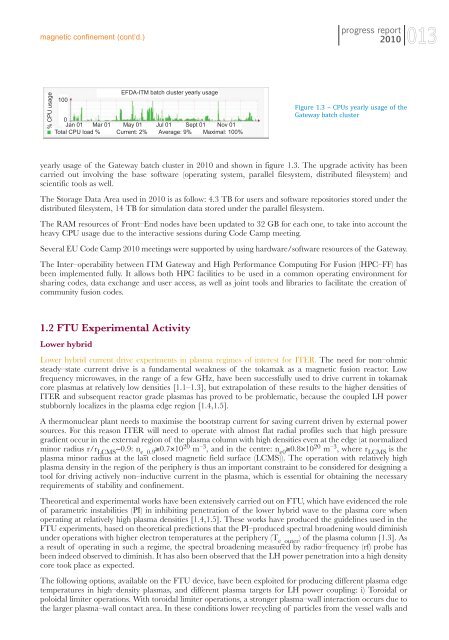Prime pagine RA2010FUS:Copia di Layout 1 - ENEA - Fusione
Prime pagine RA2010FUS:Copia di Layout 1 - ENEA - Fusione
Prime pagine RA2010FUS:Copia di Layout 1 - ENEA - Fusione
You also want an ePaper? Increase the reach of your titles
YUMPU automatically turns print PDFs into web optimized ePapers that Google loves.
magnetic confinement (cont’d.)<br />
progress report<br />
2010<br />
013<br />
% CPU usage<br />
100<br />
EFDA-ITM batch cluster yearly usage<br />
0<br />
Jan 01 Mar 01 May 01 Jul 01 Sept 01 Nov 01<br />
Total CPU load % Current: 2% Average: 9% Maximal: 100%<br />
Figure 1.3 – CPUs yearly usage of the<br />
Gateway batch cluster<br />
yearly usage of the Gateway batch cluster in 2010 and shown in figure 1.3. The upgrade activity has been<br />
carried out involving the base software (operating system, parallel filesystem, <strong>di</strong>stributed filesystem) and<br />
scientific tools as well.<br />
The Storage Data Area used in 2010 is as follow: 4.3 TB for users and software repositories stored under the<br />
<strong>di</strong>stributed filesystem, 14 TB for simulation data stored under the parallel filesystem.<br />
The RAM resources of Front–End nodes have been updated to 32 GB for each one, to take into account the<br />
heavy CPU usage due to the interactive sessions during Code Camp meeting.<br />
Several EU Code Camp 2010 meetings were supported by using hardware/software resources of the Gateway.<br />
The Inter–operability between ITM Gateway and High Performance Computing For Fusion (HPC–FF) has<br />
been implemented fully. It allows both HPC facilities to be used in a common operating environment for<br />
sharing codes, data exchange and user access, as well as joint tools and libraries to facilitate the creation of<br />
community fusion codes.<br />
1.2 FTU Experimental Activity<br />
Lower hybrid<br />
Lower hybrid current drive experiments in plasma regimes of interest for ITER. The need for non–ohmic<br />
steady–state current drive is a fundamental weakness of the tokamak as a magnetic fusion reactor. Low<br />
frequency microwaves, in the range of a few GHz, have been successfully used to drive current in tokamak<br />
core plasmas at relatively low densities [1.1–1.3], but extrapolation of these results to the higher densities of<br />
ITER and subsequent reactor grade plasmas has proved to be problematic, because the coupled LH power<br />
stubbornly localizes in the plasma edge region [1.4,1.5].<br />
A thermonuclear plant needs to maximise the bootstrap current for saving current driven by external power<br />
sources. For this reason ITER will need to operate with almost flat ra<strong>di</strong>al profiles such that high pressure<br />
gra<strong>di</strong>ent occur in the external region of the plasma column with high densities even at the edge (at normalized<br />
minor ra<strong>di</strong>us r/r LCMS<br />
∼0.9: n e_0.9<br />
≥0.7×10 20 m –3 , and in the centre: n e0<br />
≥0.8×10 20 m –3 , where r LCMS<br />
is the<br />
plasma minor ra<strong>di</strong>us at the last closed magnetic field surface (LCMS)). The operation with relatively high<br />
plasma density in the region of the periphery is thus an important constraint to be considered for designing a<br />
tool for driving actively non–inductive current in the plasma, which is essential for obtaining the necessary<br />
requirements of stability and confinement.<br />
Theoretical and experimental works have been extensively carried out on FTU, which have evidenced the role<br />
of parametric instabilities (PI) in inhibiting penetration of the lower hybrid wave to the plasma core when<br />
operating at relatively high plasma densities [1.4,1.5]. These works have produced the guidelines used in the<br />
FTU experiments, based on theoretical pre<strong>di</strong>ctions that the PI–produced spectral broadening would <strong>di</strong>minish<br />
under operations with higher electron temperatures at the periphery (T e_outer<br />
) of the plasma column [1.3]. As<br />
a result of operating in such a regime, the spectral broadening measured by ra<strong>di</strong>o–frequency (rf) probe has<br />
been indeed observed to <strong>di</strong>minish. It has also been observed that the LH power penetration into a high density<br />
core took place as expected.<br />
The following options, available on the FTU device, have been exploited for producing <strong>di</strong>fferent plasma edge<br />
temperatures in high–density plasmas, and <strong>di</strong>fferent plasma targets for LH power coupling: i) Toroidal or<br />
poloidal limiter operations. With toroidal limiter operations, a stronger plasma–wall interaction occurs due to<br />
the larger plasma–wall contact area. In these con<strong>di</strong>tions lower recycling of particles from the vessel walls and













